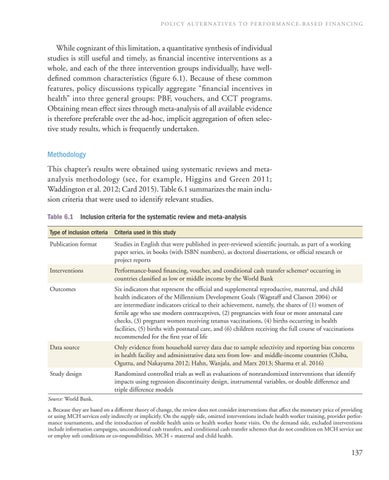POLICY ALTERNATIVES TO PERFORMANCE-BASED FINANCING
While cognizant of this limitation, a quantitative synthesis of individual studies is still useful and timely, as financial incentive interventions as a whole, and each of the three intervention groups individually, have welldefined common characteristics (figure 6.1). Because of these common features, policy discussions typically aggregate “financial incentives in health” into three general groups: PBF, vouchers, and CCT programs. Obtaining mean effect sizes through meta-analysis of all available evidence is therefore preferable over the ad-hoc, implicit aggregation of often selective study results, which is frequently undertaken. Methodology This chapter’s results were obtained using systematic reviews and metaanalysis methodology (see, for example, Higgins and Green 2011; Waddington et al. 2012; Card 2015). Table 6.1 summarizes the main inclusion criteria that were used to identify relevant studies. Table 6.1 Inclusion criteria for the systematic review and meta-analysis Type of inclusion criteria
Criteria used in this study
Publication format
Studies in English that were published in peer-reviewed scientific journals, as part of a working paper series, in books (with ISBN numbers), as doctoral dissertations, or official research or project reports
Interventions
Performance-based financing, voucher, and conditional cash transfer schemesa occurring in countries classified as low or middle income by the World Bank
Outcomes
Six indicators that represent the official and supplemental reproductive, maternal, and child health indicators of the Millennium Development Goals (Wagstaff and Claeson 2004) or are intermediate indicators critical to their achievement, namely, the shares of (1) women of fertile age who use modern contraceptives, (2) pregnancies with four or more antenatal care checks, (3) pregnant women receiving tetanus vaccinations, (4) births occurring in health facilities, (5) births with postnatal care, and (6) children receiving the full course of vaccinations recommended for the first year of life
Data source
Only evidence from household survey data due to sample selectivity and reporting bias concerns in health facility and administrative data sets from low- and middle-income countries (Chiba, Oguttu, and Nakayama 2012; Hahn, Wanjala, and Marx 2013; Sharma et al. 2016)
Study design
Randomized controlled trials as well as evaluations of nonrandomized interventions that identify impacts using regression discontinuity design, instrumental variables, or double difference and triple difference models
Source: World Bank. a. Because they are based on a different theory of change, the review does not consider interventions that affect the monetary price of providing or using MCH services only indirectly or implicitly. On the supply side, omitted interventions include health worker training, provider performance tournaments, and the introduction of mobile health units or health worker home visits. On the demand side, excluded interventions include information campaigns, unconditional cash transfers, and conditional cash transfer schemes that do not condition on MCH service use or employ soft conditions or co-responsibilities. MCH = maternal and child health.
137

